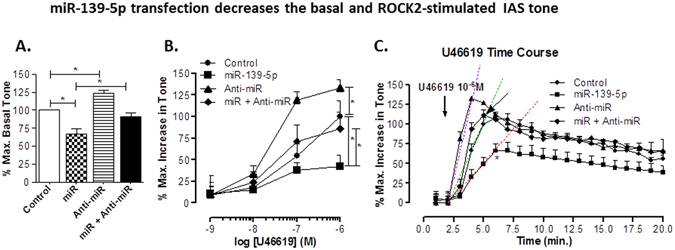Figure 5.

Effect of miRNA- and anti-miRNA-139-5p. (A) miRNA-139-5p (100 nM) produces significant (*p < 0.05; n = 5) decrease in the IAS tone, as compared with scrambled miRNA (control), which is significantly blocked by pre-treatment with 100 nM antagomir (*p < 0.05; n = 5). Conversely, 100 nM antagomir by itself significantly (*p < 0.05; n = 4) increases the IAS tone as compared to control. (B) miRNA-139-5p significantly shifts U46619 CRC causing an increase in the IAS tone towards right (*p < 0.05; n = 6–8), which is attenuated by the antagomir. In contrast, the antagomir causes a significant shift in the control CRC to left (p > 0.05; n = 6–8). (C) Time course data with U46619 (1 μM) before and after miRNA-139-5p show a significant (*p < 0.05) decrease in the maximal increase in the IAS tone and increase in the time taken to achieve it following miRNA-139-5p transfection. The above described effect of miRNA-139-5p is significantly (*p < 0.05) attenuated by the pre-transfection of the smooth muscles with anti-miRNA-139-5p. Conversely, anti-miRNA-139-5p significantly (*p < 0.05) increases the maximal effect and produces left-ward shift in time-course of U46619-induced contraction. Changes in the shifts in the kinetic velocities following U46619 are shown by the regression analyses with dashed lines.
